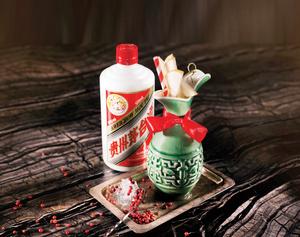In existence since the Song Dynasty, and a staple of Chinese banquets, baijiu is being reinvented to cater to a younger and international market. Joyce Yip reports.
 An aging tunnel at Luzhou Laojiao Baijiu Distillery in Sichuan. The Ming River Sichuan Baijiu brand, targeted at the international market, was the result of a tie-up with the Luzhou distillery. (PHOTO PROVIDED TO CHINA DAILY)
An aging tunnel at Luzhou Laojiao Baijiu Distillery in Sichuan. The Ming River Sichuan Baijiu brand, targeted at the international market, was the result of a tie-up with the Luzhou distillery. (PHOTO PROVIDED TO CHINA DAILY)
In the summer of 2016, Antonio Lai, a mixologist who runs Quinary, a bar in Hong Kong’s Central, was approached by baijiu manufacturer Kweichow Moutai. Lai was asked to consider using the Moutai brand in a monthly special cocktail. Three weeks later, he had perfected Dear Jade, a concoction of pear puree, cardamom, pink peppercorn syrup, champagne and the sought-after Chinese spirit. He served the cocktail in a jade-colored flask, embellished with a ribbon that was the same fiery shade of red as Kweichow Moutai’s label.
This is no easy feat even for a multi-award winning bartender of international repute as Lai. Moutai, a type of baijiu — or Chinese white wine — is known not only for its 50-plus ABV, but also the wide variety of curiously contradictory flavors that it comes in — overripe tropical fruit, cheese, soy sauce, licorice, anise, caramelized shiitake mushrooms, gasoline, toasty rice, old socks and more.
For instance, Kweichow Moutai can taste like caramel when it’s hot and also give off hints of peach, lychee and apricot when served cold.
“From a bartender’s point of view, baijiu is super heavy: it’s more of an enhancement than a core ingredient,” says Lai. No more than 10 ml of baijiu was used in Dear Jade, but it was enough to leave an impression.
“It was a good way for me to showcase a bit of Chinese history and that something as challenging as baijiu could be used in a cocktail,” Lai says.
 Mixologist Antonio Lai says respecting the spirit’s history and knowing what to pair it with can help enhance one’s appreciation of baijiu. (PHOTO PROVIDED TO CHINA DAILY)
Mixologist Antonio Lai says respecting the spirit’s history and knowing what to pair it with can help enhance one’s appreciation of baijiu. (PHOTO PROVIDED TO CHINA DAILY)
Repackaging tradition
Mainly extracted from sorghum, a cereal grain, baijiu comes in aroma styles of strong, light, sauce, or rice, usually depending on where it’s brewed. Kweichow Moutai, for instance, is sauce-style and known for its umami saltiness. It’s a favorite toast at Chinese banquets and business dinners. According to baijw.com, 7.4 million kiloliters of baijiu was produced in 2020.
Prices vary, depending on the quality. A bottle can cost anywhere from a few yuan to the price of an iPhone or two. Aged bottles can fetch hammer prices on a par with rare whiskies. Baijiu is said to be the only alcoholic beverage presented as a diplomatic gift at Chinese embassies.
Despite its long history, baijiu’s popularity remains within China. However, in recent years, a handful of distillers are trying to repackage baijiu for the international palate.
In 2012, Jiangxiaobai distillery in Chongqing started packaging its light-aroma baijiu in blue and white bottles. On the label is a bilingual logo, an anime-like mascot called Xiaobai, a nickname that could also mean a rookie’s zeal; as well as sentimental quotes like “I hope to pour you baijiu after 10 years, and that we are still old friends then”.
Evidently, Jiangxiaobai has an eye on the local millennial market. The company has hosted a myriad of events, including music concerts, street dance and street art, in order to promote the brand in China. It has also entered World Cocktail Championships and is now available in markets across the UK, India, Malaysia and South Africa and supposedly earned over 2 billion yuan (US$309.5 million) in 2018.
 Ming River Sichuan Baijiu ambassador Christian Wu stirs up a heady brew. (PHOTO PROVIDED TO CHINA DAILY)
Ming River Sichuan Baijiu ambassador Christian Wu stirs up a heady brew. (PHOTO PROVIDED TO CHINA DAILY)
Exploring foreign markets
Baijiu seems to go down better as a cocktail ingredient when served to a Western drinker. Cocktails are the “driving medium”, says Derek Sandhaus, the author of In Baijiu: The Essential Guide to Chinese Spirits, founder of the Drink Baijiu blog and co-founder of the Ming River Sichuan Baijiu brand.
“The rise in the West of other once-alien spirits backs up this theory,” says Sandhaus. “Vodka was considered Russian rotgut until the Moscow mule and, later, James Bond’s vodka martini (shaken, not stirred). Tequila, likewise, was propelled to stardom via the margarita.”
Baijiu’s popularity in business settings comes with a degree of notoriety. It is seen as the spirit people are pushed to consume in excessive quantities because of peer pressure. A 2017 World Health Organization report estimates Chinese people will be drinking 10 liters of alcohol per capita per year by 2030, overtaking the US average. Nevertheless, the popularity of the national spirit, mixed with delicious syrups and topped with a colorful ombre in a fancy glass, continues to grow.
 The Dear Jade cocktail created by Hong Kong mixologist Antonio Lai contains pear puree, cardamom, pink peppercorn syrup, champagne and a dash of Kweichow Moutai brand baijiu. (PHOTO PROVIDED TO CHINA DAILY)
The Dear Jade cocktail created by Hong Kong mixologist Antonio Lai contains pear puree, cardamom, pink peppercorn syrup, champagne and a dash of Kweichow Moutai brand baijiu. (PHOTO PROVIDED TO CHINA DAILY)
“If your first experience of whisky is of Scots telling you to drink a bottle of it, you’d have less people liking it,” says Sandhaus. “Undeniably, there’s a bit of prejudice that goes in from the US and European points of view. Many people in the world still see Chinese food as cheap and low-class. This affects the way people see all sorts of Chinese products.”
“Baijiu as a modern, premium product didn’t exist until the second half of the 20th century. So it does take time to gain a global following,” Sandhaus adds.
He created Ming River Sichuan Baijiu in partnership with the fourth-biggest baijiu producer, Luzhou Laojiao. The ABV has been kept to 45 percent to enhance the brand’s appeal as a cocktail ingredient.
Although it is not sold on the Chinese mainland, the packaging design of Ming River Sichuan Baijiu references elaborate Chinese banquets. The English name was chosen to attract an international audience.
“If you don’t speak Mandarin, you can’t pronounce Luzhou Laojiao. It’s a superficial but important change if you want people in the West to order it,” Sandhaus says.
 Ming River Sichuan Baijiu co-founders Bill Isler (left), the writer Derek Sandhaus (center) and Matthias Heger. (PHOTO PROVIDED TO CHINA DAILY)
Ming River Sichuan Baijiu co-founders Bill Isler (left), the writer Derek Sandhaus (center) and Matthias Heger. (PHOTO PROVIDED TO CHINA DAILY)
Palatable spin-offs
Besides producing a less alcoholic spirit in a range of fluorescent colors, UK-based Baijiu Society has come up with spin-offs like baijiu-infused beer and coffee liqueurs to “introduce Chinese baijiu in a way that’s more accessible,” says founder Craig Butler.
“We are not here to change baijiu, but play with the different levels of flavors to get something that we know the Western palates will love, such as ripe fruit, pear, banana, while toning down elements like umami that we find difficult to deliver,” Butler adds.
Butler’s target market is Western beer-lovers and gin-drinkers. He sounds confident that people with gin-fatigue will eventually hop onto his “baijiu and tonic” bandwagon.
Sandhaus, however, feels baijiu should be appreciated as it is.
“I think you’re skipping a step here. Before people drink flavored vodka they have to know and like vodka. Sure, baijiu isn’t mainstream but you can’t start by adding and mixing things up,” Sandhaus says.
He’s more forgiving when it comes to cocktails, saying that infusions of medicinal ingredients like fruits and antlers, have been part of the practice since baijiu’s inception in the Song Dynasty (960-1279 CE). Plus, cocktails help ease the spirit into food pairing, which fits in with baijiu’s traditional role.
Sandhaus hopes that distilleries in China will join forces to spread the gospel of the national drink around the world. However, there is scant motivation to do so, given the heavy domestic demand. Even in a pandemic-ridden 2020, Kweichow Moutai saw a 7.2 percent growth in its July-September quarter and boasts a market value of US$39.3 billion, which makes it the most profitable spirit brand in the world.
Back in Hong Kong, Lai liked the Kweichow Moutai brand so much that he included it in a pairing menu at Vea, where he is an executive mixologist. The concoction of plum syrup, black vinegar and just 5 ml of the prized liquor goes beautifully with crystal caviar with Alaska King Crab. The idea was inspired by the tradition of balancing plum soup (suanmeitang) with crab, says Lai.
“As long as we continue to consider the taste of the spirit and respect the history of how it’s made and its pairing cuisine, we can appreciate baijiu,” Lai says.


